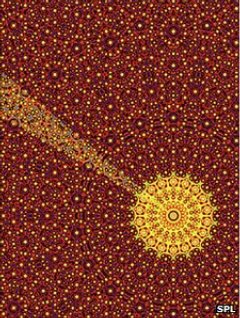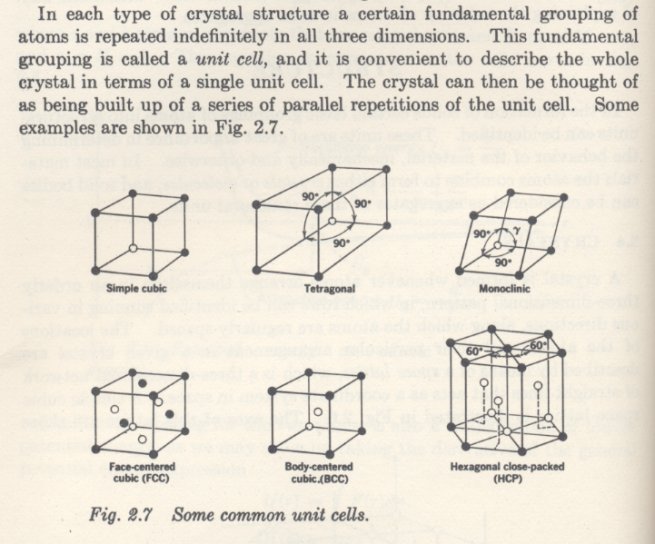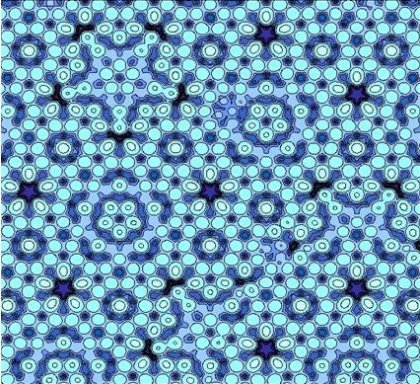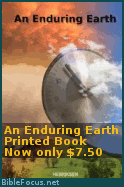
Every now and then there is a discovery about the detail in nature which is beautiful. Not long after the self similar patterns of the Mandelbrot set were being visualised using computer, in 1982 the researcher Dr Daniel Shechtman was finding evidence for complex non-repeating patterns at the atomic level in certain crystal structures called quazicrystals and saying out loud, "there can be no such creature".
But we might expect such a creature from a Creator who loves patterns in complexity in the things he makes. Our world is full of patterns in forms and types.
The detail of the patterns of the Bible is amazing. From the overall picture of redemption, to the redemption pattern in the lives of people such as Joseph, to the detail of the occurrence of precise words used (even in some translations), to even the letters in Hebrew, the Bible shows the hand of one Designer. Just as we see this in the Bible it ought not to be surprising that we see ever increasing levels of complexity and similarity in pattern the more we look at the detail in nature.
Dr Shechtman knew what he had found did not fit established theory on crystals. He reported,
"The head of my lab came to me smiling sheepishly, and put a book on my desk and said: 'Danny, why don't you read this and see that it is impossible what you are saying,'" BBC
It has been reported he was so ridiculed for his discovery that he left the lab at the National Institute of Standards and Technology, Washington and went to Technion, Israel Institute of Technology in Haifa and published his research from there in 1984. But his findings have now been confirmed and recognized and he was awarded the Nobel prize in Chemistry.
The Royal Swedish Academy of Sciences said in a statement that Schechtman's research “eventually forced scientists to reconsider their conception of the very nature of matter.” Israel National News
To explain the background and why it is remarkable:

Everything in our world which we might think solid including minerals, plants, animals and humans is made up of atoms bonded together in stable formations. Whereas the atomic arrangement of plants, animals and humans are somewhat complex, it was found that minerals, rocks, metals and lots of very useful materials had simple chemical structures that formed physical repeating patterns as either crystals or molecules. Cyrstals are not only clear rocks, but in Materials science and Solid State Physics refers to any solid exhibiting the crystal structure including iron, gypsum, marble and gold. Gold has a 'face centred cublic' (see figure) crystalline structure. Iron is body centred cubic.
Crystals can be drawn in diagram form and can be described mathematically. The repetition meant that each material could be described by its most simple part. It was found that the basic shape formed by the atoms of a crystal, whether a cube or an hexagonal extrusion or whatever shape it was, determined its physical properties when placed under loads such as for buildings or in aeroplanes or the kind of beating a tennis racquet receives. When something solid breaks in two pieces in your hands, the bonds between atoms have broken (not the atoms themselves as when atoms brake apart we don't want to be nearby). It has been useful and beautiful to find that most solid substances can be simply described because they are a huge collection of one type of a structure in an endlessly repeating pattern. All text books on engineering materials say crystals are formed from fundamental grouping of atoms endlessly repeating. It was a statement based on observation.
But it seems that in addition to the observed beauty or repeating patterns there are useful solids which have bonds between atoms in a crystal-like structure with even more beautiful non-repeating regular patterns.
“The Nobel laureate first created quasicrystals by rapidly cooling molten metals, such as aluminium and manganese, by squirting the mixture onto a cool surface...
Following Dr Shechtman's discovery, scientists have formed other kinds of quasicrystals in the lab, and a naturally forming example has been found among mineral samples from a Russian river.
Quasicrystal (Credit: SPL) The "forbidden symmetry" of the quasicrystal was first spied in 1982
Quasicrystal structures tend to be hard, non-sticky and are poor conductors of heat and electricity. These properties make them useful as coatings for frying pans and as insulating material for electrical wires. They are also found in the world's most durable steel, used in razor blades and ultra-fine needles in eye surgery. "It's a great work of discovery, with potential applications that range from light-emitting diodes to improved diesel engines," said the president of the American Chemical Society, Nancy Jackson.
Dr Andrew Goodwin, from the department of chemistry at Oxford University, added: "Shechtman's quasicrystals are now widely used to improve the mechanical properties of engineering materials and are the basis of an entirely new branch of structural science.
"If there is one particular lesson we are taking from his research, it is not to underestimate the imagination of nature herself." BBC
The last comment implies nature itself is a 'being' with a capacity to think. Dr Goodwin has made nature a goddess. He is being objective speaking of 'imagination', but what evidence he has for calling the source of imagination “nature” and “her” is not evident.
Certainly the evidence shows that humans underestimated the complexity of the way the world is made. They did so as the dominant theory in science assumed that all life had happened to form by chance through 'laws'. This finding changes the theory of crystals, and challenges philosophical theoreticians to find an explanation not only for just how so many elements and useful substances happened to occur on earth, but how some seem to be made with patterns so complex. The word that best describes the evidence that can be seen in the making of the form of quasicrystals is “imagination”. The question that might be asked is how is it that atoms, that have no mind of their own, bond in such beautiful patterns? How is it that simple 'laws' are so complex and beautiful?

The best analogy to the explain the pattern is the creation made from the work of a talented imagination,
Irregular shapes, similar to what Dr Shechtman was seeing, are found in the medieval Islamic mosaics of the Alhambra Palace in Spain. The tiles that line the walls and floors of the palace are regular, and follow mathematical rules, but also never repeat themselves. BBC
Once again this is further evidence that the world is made with imagination, implying a Creator.
Prior to his discovery, crystals were thought to only have repeating patterns.
"The main lesson I learned over time is that a good scientist is a humble scientist, not one who is 100 percent sure," Shechtman said. JPost
The implication is that humans, even collectively, cannot know everything. As humans make more powerful tools we can see more and more complex and beautiful detail.
In the same way a Bible student can see more detail as they look more in the Bible, and there seems more self similar pattern at each level of detail. We have been blessed in this age by being able to 'see' the beauty in the patterns of atoms.
"The Titan Microscope, which is considered the most advanced of its field, is a high resolution electron microscope that can easily detect atoms and is used for discoveries," Ynet
The Bible anticipated that we might see a 'line', or as the Hebrew implies a 'binding', 'a cord' or a measuring cord, at all levels throughout the earth from the rotation of the earth about the sun to the forces that hold or bind atoms together.
A Psalm of David. The heavens declare the glory of God; and the firmament shows his handywork. Day unto day utters speech, and night unto night shows knowledge. There is no speech nor language, where their voice is not heard. Their line is gone out through all the earth, and their words to the end of the world. ... His going forth is from the end of the heaven, and his circuit unto the ends of it: and there is nothing hid from the heat thereof. The law of the LORD is perfect, converting the soul: the testimony of the LORD is sure, making wise the simple. (Psalm 19:1-7)
This binding force (as if an invisible 'cord') is observable and can be quantified from the rotation of planets, to the bonds throughout all the earth holding together the atoms of matter in their various shapes, including the non-repeating patterns of the quazicrystals.
The Apostle Paul was no simpleton, but a very educated man and he declared against the myths of goddesses of the Ancient Greeks,
God that made the world and all things therein, seeing that he is Lord of heaven and earth, dwells not in temples made with hands; (Acts 17:24)
Job makes a statement perhaps more clear than that of Dr Goodwin, and certainly no less a matter of observation regarding the God of the Bible,
He puts forth his hand upon the rock; he overturns the mountains by the roots. He cuts out rivers among the rocks; and his eye sees every precious thing. (Job 28:9-10)
We have evidence now that by imagination the crystal and quasi crystal were made for beauty by an intelligent Creator. Even the BBC quotes a scientist this view. It is up to the individuals to determine who is the intelligent Creator. Humans can only observe and wonder.
The Bible has not dated as Greek philosophy/science or Ancient Egyptian science, or even modern Western Science, has. How was it that the ancient Hebrews from the earliest times of human writing never made such provably inaccurate statements as the later writings of the Ancient Greeks? Was it because the Bible claims are true and these men wrote the word of the powerful and creative God of Israel?
More than that, the Bible gets right to the main point. The world is wonderful, and humans may search out and find many things,
These are also proverbs of Solomon, which the men of Hezekiah king of Judah copied out. It is the glory of God to conceal a thing: but the honour of kings is to search out a matter. The heaven for height, and the earth for depth, and the heart of kings is unsearchable. Take away the dross from the silver, and there shall come forth a vessel for the finer. (Proverbs 25:1-4)
The Bible indicates that no matter how much we find there will be more to find. We will find it both in the physical things of our world and also in plumbing the complexity of the human mind and condition. In addition God reserves the right not to tell us everything and to even hide things in nature from us, so we may have the wonder and honour of finding out what he has done.
The Bible curiously also explains the findings of research science, and explains a fact which is ever more evident in the era where knowledge has increased as Daniel was told (Daniel 12:4),
I have seen the travail, which God has given to the sons of men to be exercised in it. He has made every thing beautiful in his time: also he has set the world in their heart, so that no man can find out the work that God makes from the beginning to the end. (Ecclesiastes 3:10-11)
Once again a human theory has been overturned by evidence. This evidence adds to the increasing evidence for a Creator. The more humans find, the less certain they can be, and the more they understand they cannot confirm even things they may be able to understand as possible. The behaviour and properties of Quazicrystals may be understood, but science cannot explain why the bonds form between atoms. Yet King David in the songs for ancient Isarel spoke of that invisible binding 'cord' as the word of God. From this viewpoint we might understand why the atoms form such beautiful patterns.
We can understand the creative act. Humans like order and patterns and will make both repeating and non-repeating patterns. Humans can be creative. There is beauty in the logic that the Bible reveals both that we are made in the image of God (Heb: Elohim) and that the Creator is imaginative and designs things such as the Tabernacle. It adds to the wonder of this that we can find both repeating and non-repeating patterns in the atomic world all held together by an invisible 'binding' put in place by a creative and an imaginative God.
For more Doing Things in Space

We have heard this question asked, and will discuss the issues with it. And in the process we will give an astounding answer, that will hopefully make you think.

An article prompted by National DNA day April 25 celebrating the understanding of DNA.

It has been in my heart to write about an observation regarding the movement in the heavens : weather, climate, sun and universe. It concerns me that people do not give the God of the Bible the glory for His gift of life, moment to moment, and the giving of rain and sun.
For a while now I have been dissatisfied with explanations to rebut Evolution. Over a year ago I was asked by someone to think upon how I would answer in favour of the Bible account of creation.

Some things strike us as interesting. Someone thought the world would be interested that a 'Gamma-ray burst 'hit Earth in the 8th Century'. It was a long time ago. Yet a bunch of scientists have found traces of such an event and are now asking 'why?' and the similar question 'how?'



